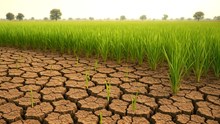
Food going to waste presents a paradoxical situation, especially when people go to bed on an empty stomach. When we speak of food waste, the term conjures up an image of a plateful of surplus eatables being dumped in the bin. But it is not actually so. The waste starts at the farm and ends up with the fork. According to the Nairobi (Kenya)-based United Nations Environment Programme (UNEP), substantial amounts of food are produced but not eaten, causing negative environmental, social and economic impacts.
Estimates suggest that 8-10% of global greenhouse gas emissions are associated with food that is not consumed. Reducing food waste at the retail, food service and household levels can provide multi-faceted benefits for both people and the planet. The United Nations and the Food and Agriculture Organization (FAO), based in Rome (Italy), says around 14% of food produced is lost between harvest and retail worldwide. Significant quantities are also wasted in retail and at the consumption level.
According to UNEP, the world already produces enough food to feed everyone on the planet and according to the recent Food Waste Index Report 2021, over 17% of food in total is wasted. According to FAO, the global volume of food wastage is estimated at 1.6 billion tons of “primary product equivalents.”
Total food wastage for the edible part of this amounts to 1.3 billion tons. UNEP says that the global average of 74 kg per capita of food wasted each year is similar from lower-middle-income to high-income countries, which means that most countries have room to improve.
This has an impact on the environment:
-
Food wastage’s carbon footprint is estimated at 3.3 billion tons of CO2 equivalent of GHG released into the atmosphere per year.
-
The total volume of water used each year to produce food that is lost or wasted (250km3) is equivalent to the annual flow of Russia’s Volga River, or three times the volume of Lake Geneva.
-
Similarly, 1.4 billion hectares of land (28% of the world’s agricultural area) is used annually to produce food that is lost or wasted.
-
Agriculture is also responsible for a majority of threats to at-risk plant and animal species tracked by the International Union for Conservation of Nature (IUCN).
-
A low percentage of all food wastage is composted. Much of it ends up in landfills and represents a large part of municipal solid waste. Methane emissions from landfills also represent one of the largest sources of GHG emissions from the waste sector.
The food wasted along the chain has a greater environmental impact because we have to take into consideration the energy and natural resources expended in processing, transporting, storing and cooking food. Around 38% of total energy consumption in the global food system is also utilized to produce food that is either lost or wasted.
In addition, it takes seeds, soil and the labour of farmers to produce food, not to mention the fuel that is needed to transport it. All of these resources are lost when food is wasted. Food waste that ends up in landfills produces a large amount of methane, a more powerful greenhouse gas than even CO2, thus contributing to climate change.
Policymakers can improve the chances of achieving climate goals and limiting global warming to 1.5°C by making more specific commitments to transforming national food systems. With agriculture accounting for 70% of the water used throughout the world, food waste also represents a great waste of freshwater and groundwater resources. It is said that a volume of water roughly three times the volume of Lake Geneva is used just to produce food that is not eaten.
If you look at land usage, around 1.4 billion hectares of land, roughly a third the world’s total agricultural land area, is used to grow food that is wasted. Millions of gallons of oil are also wasted every year to produce food that is not eaten. All these do not even take into account the negative impacts on biodiversity due to activities like monocropping and converting wild lands into agricultural areas.
Each year on 29th September, the International Day of Awareness of Food Loss and Waste Reduction is observed. Reducing food loss and waste is of significant importance as it contributes to the realization of broader improvements to agri-food systems toward achieving food security, food safety, improving food quality and delivering on nutritional outcomes. For, reducing food loss and waste also contributes significantly to the reduction of greenhouse gas emissions, as well as pressure on land and water resources.
















